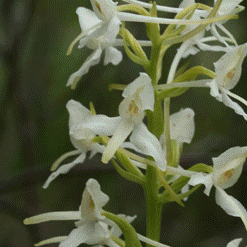

Saint-Petersburg Orchid Society
General information
Orchids are not only tropical plants. In the North, they are also present in wild nature. Although most of our Orchids don't have big flowers as their tropical relatives, they are very brightly coloured and their flowers are very quaint.
Our native Orchids are also known for their sensitivity to the changes in the environment. In the case of negative changes they answer very quickly by rapid extinction. That's why orchids become a symbol of plant conservation, the symbol of an undisturbed nature.
In North-West Russia (Leningrad, Pskov and Novgorod Regions) there are 28 Orchid species. There are 28 species in Leningrad Region, 27 species in Pskov Region and 24 species in Novgorod Region.
Human and orchids
It is well-known that among Orchids there is a lot of highly endangered taxa. Unfortunately , North - West European Russia is not an exception .
Among 28 Orchid species, only 10 are not endangered. All other species either become more and more rare, or stand at a quick way to extinction. We consider Calypso bulbosa , Neotinea ustulata, Ophrys insectifera, Cephalanthera rubra, Herminium monorchis and Cypripedium calceolus to be extremely vulnerable. Fortunately, yet there are no extinct species in our flora, but Calypso bulbosa , Neotinea ustulata, Ophrys insectifera, Cephalanthera rubra and Herminium monorchis are at high risk. The extinction of Calypso bulbosa and Neotinea ustulata might take place in nearest years.
There are several reasons explaining the extinction of Orchids. Of the highest importance are the changes in agricultural and silvicultural methods in last centuries. Due to the decreasing of the countryside inhabitants, there are specific changes in meadow management. There is a substantial decrease of hay mowing, and grazing with meadow eutrophication and overgrowing by bushes as a consequence. This results in the substantial reduce in quantity of the meadow plants, as Cephalanthera rubra, Herminium monorchis, Neotinea ustulata, Ophrys insectifera, Orchis militaris.
There are also important changes in silviculture. Instead of logging in small parts of the forest, huge clearings become more and more usual. Orchid species, which grow in forests, usually do not grow in young plantations with trees of the same age. In those small fragments of primary forests which remain the old trees are no more removed and brushwood is no more gathered. As the result, primary forests become totally blocked up with fallen trees. These are the the reasons for reducing in quantity of the forest Orchids, viz. Calypso bulbosa, Epipogium aphyllum, Neottia nidus-avis, Listera cordata and Corallorhiza trifida . Our most rare Orchid Calypso bulbosa , moreover, is on its southern distribution limit in Leningrad Region. Therefore it is especially sensitive to the changes of silvicultural methods and to the changes in forest vegetation.
Another important reason explaining the extinction of Orchids is direct gathering of the plants by people. This concerns very much Cypripedium calceolus , but it is also important for Calypso bulbosa, Cephalanthera rubra, Gymnadenia conopsea and other species. People collect Orchids for making bunches and sometimes transplant them to the dachas and countryside cottedges, hoping erroneously that they are saving plants from the inevitable death in the nature. Concerning gathering Orchids for sale, this is a real sacrilege.
It does no harm to remind, that the transplantation of Orchids from the natural communities to the gardens is very often unsuccessful even for the professional gardeners. Orchids are highly sensitive to the changes in ecological conditions, it is extremely difficult to successfully transpalnt the symbiotic fungi; therefore, Orchids hardly endure the transplantation. It is an often thing that the plants die after one or two years in the new place, which makes an illusion of the successful transplantation. It is also very important that even if the transplantation proved to be effective, this makes no less harm, because these plants are anyway loosed for the nature as a specimen for reproduction.
 |